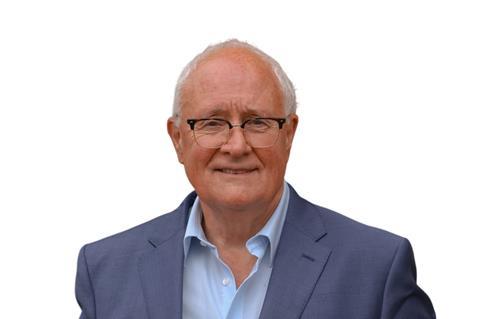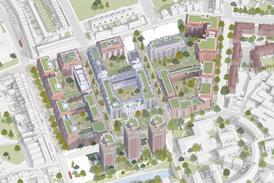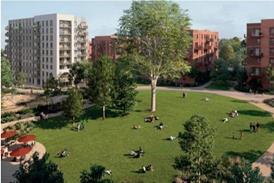Only by adopting an ambitious, long-term mindset and working in partnership will we manage to build those 1.5 million homes, writes Sir Michael Lyons, chair of the New Towns Taskforce
The government’s 1.5 million homes target is one of the most demanding housing challenges we have seen. The sector can meet it, but to do so the approach must include bold action on every front.

To overcome the scale of the housing crisis – and alongside developing new towns across the country – we will need to continue to look at opportunities in communities too often overlooked for investment.
My position as chair of the New Towns Taskforce and non-executive chair of ECF, the partnership between Homes England, L&G, and Muse, provides a unique perspective of seeing the challenge from both sides.
We said in the recent report from the taskforce, which includes a shortlist of 12 new towns, that the initiative is not just about stimulating growth and building houses, but creating thriving communities, neighbourhoods with a sense of place, shaped by local needs. The key is investing in social and economic infrastructure, transport connections and environmental resilience for sustainable communities.
The report is set in the context of ambitious government leadership and the creation of placemaking partnerships with landowners and developers to make these towns a reality, which mirrors the approach we have taken at ECF for more than two decades.
Of course, some of our recommended locations involved the reshaping of existing urban centres.
There is much that new towns and regeneration have in common, from challenges around assembling land at scale, often with multiple owners, initial infrastructure investment and navigating the lengthy and uncertain planning system.
Many urban sites are dismissed by mainstream developers. It can be easier to walk away if approached with a short-term mindset
Created through an earlier government initiative, ECF combines public influence with private skills and investment. This model enables the partnership to overcome challenges and take on sites others would not, particularly brownfield land in towns and cities that have historically been considered too complicated, uncertain and ultimately unviable.
Many urban sites are dismissed by mainstream developers. It can be easier to walk away if approached with a short-term mindset, especially with returns being slower than on greenfield land.
By combining Homes England’s public influence, L&G’s capital and Muse’s regeneration expertise, we absorb those longer timelines, managing risks others avoid and bringing long-term value, with communities people are proud to call home.
Since 2001, ECF has built more than 2,900 homes and, through long-term placemaking, developed neighbourhoods that support thriving communities, economically, socially and environmentally.
From our flagship development in Salford, through Wakefield and Bradford, to Merseyside, London and Plymouth, we are delivering forward-looking regeneration. Each development is rooted in local ambitions with a distinct identity.
This approach has found favour with other local communities, with six new locations currently in design or under negotiation.
On the south coast at Millbay in Plymouth, ECF partnered with Plymouth council to transform the city’s historic docks from a derelict site into a waterfront community – with 600 homes, a 1,000-pupil school and 40,000sq ft of office and retail space. There are homes for first-time buyers, families and downsizers. This is a renewed diverse coastal neighbourhood supported by education, culture and job opportunities.
At Merchant Gate, ECF created a mixed-use neighbourhood next to the train station in Wakefield. By partnering with Wakefield council, 66 new homes, shops and restaurants have been built on redundant land. We created a space that reconnects people with the city centre and restores a pride in the place to an area that had been neglected.
>>See also: Sector leaders welcome new towns announcement but warn of viability and infrastructure challenges
There is one key theme at the heart of both projects and that is robust partnerships; this regeneration was only possible through strong partnership with a commitment to long-term investment.
This is a lesson that is reflected in the report from the taskforce: the government will need to act in the national interest to engage and create partnerships with landowners, developers and builders to create the homes we desperately need.
The cost of overlooking communities that may already feel forgotten is stark. Across the UK, there will be derelict sites which drag down confidence, deter investment and serve to prolong the cycle of decline
By pursuing new towns and regeneration at the same time, we can deliver both the scale and quality the country needs.
We must act now on both fronts. The cost of overlooking communities that may already feel forgotten is stark. Across the UK, there will be derelict sites which drag down confidence, deter investment and serve to prolong the cycle of decline.
Our work demonstrates how new life can be breathed into communities through unlocking regeneration in areas that have previously been passed over, while the report highlights how new towns will be central to meeting local demand.
The challenge is significant, but the opportunity is greater. Through strong action we can rebuild confidence in investors and with the public, proving the country can deliver the homes and infrastructure that people need.
We need ambition to create new towns and determination to regenerate communities, both aims grounded in a partnership. If taken together, we will be moving in the right direction towards hitting that target of 1.5 million homes.
Postscript
Sir Michael Lyons is non-executive chair of ECF, a placemaking partnership between Homes England, L&G and Muse. He also chaired the New Towns Taskforce
















No comments yet